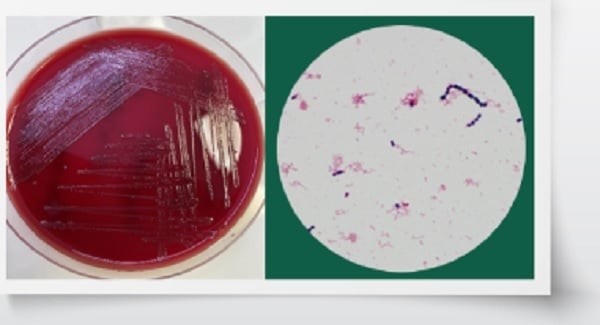On September 20, information from Military Hospital 175 said that the hospital had just discovered a sample of cerebrospinal fluid from a 59-year-old male patient sent from the Department of Infectious Diseases; the fluid was cloudy, white blood cells increased, and protein increased.
According to Dr. Nguyen Thi Trang (Microbiology Department, Military Hospital 175), the staining results showed Gram-positive cocci, standing alone, standing in pairs, short chains, the culture results and identification were Streptococcus suis (swine streptococcus).
Medical history revealed that 10 days ago the patient had fever and body aches. He was treated at a lower-level hospital and diagnosed with acute viral infection. The disease was stable and he was discharged from the hospital.
Three days later, the patient had a fever again, accompanied by chills, mild headache, then severe headache, no vomiting, self-medication with painkillers did not help, became agitated, screamed and was hospitalized at the Department of Infectious Diseases, Military Hospital 175.
Here, the patient was diagnosed with purulent meningitis in a patient with hypertension, type 2 diabetes, and chronic gout. The patient was assigned to perform paraclinical tests, including a lumbar puncture and sent to the Microbiology Department for culture. The culture results of Streptococcus suis (swine streptococcus) promptly supported the clinicians in choosing antibiotics for treatment.
Doctors assessed the risk factors for the disease to be due to the patient raising pigs and slaughtering pigs 2 weeks before the onset of the disease.

Methods of microbiological diagnosis of swine streptococcus
Causes and symptoms of streptococcus suis
According to Dr. Trang, Streptococcus suis is a bacterium that resides in the upper respiratory tract (nose, throat), genital tract and digestive tract of pigs, causing severe infections in pigs and can spread to humans. The main route of transmission is through contact, due to the use of unsafe pork products such as people with small wounds or scratches on the skin during direct contact with pigs carrying bacteria, slaughtering, processing pork and the process of raising pigs are very susceptible to Streptococcus suis infection.
People who eat undercooked pork products such as blood pudding, salad, spring rolls, and pig organs infected with streptococcus are also susceptible to streptococcus suis infection. However, there is no evidence of human-to-human transmission of streptococcus suis.
The incubation period is short, from a few hours to 2-3 days, in some cases it can last up to several weeks. The most common clinical picture is meningitis with symptoms of high fever, headache, nausea, vomiting, tinnitus, deafness, stiff neck, impaired perception, subcutaneous hemorrhage in the form of spots and patches on the ear rim, nose, face, trunk, etc., cloudy cerebrospinal fluid, increased pressure, increased white blood cells and protein. Severe cases cause sepsis, septic shock, severe blood clotting disorders, multiple organ failure, gastrointestinal bleeding, coma, and rapid death.
How to prevent streptococcus suis
According to Dr. Trang, there is currently no vaccine to prevent the disease. To prevent Streptococcus suis, people should buy pork that has been inspected by veterinary agencies, avoid buying pork with unusual red color, bleeding or swelling. Do not eat dead or undercooked pigs, especially pig blood pudding during the epidemic. People with open wounds must wear gloves when handling undercooked or raw pork.
Processing equipment must be kept clean and used separately for raw and cooked meat. Wash hands and processing equipment after handling and processing pork. Do not slaughter or transport sick pigs. Dead pigs must be properly destroyed. Sick and dead pigs must be buried, disinfected and destroyed. Barns and the breeding environment must be sprayed with disinfectants.
Source link




![[Photo] "Beauties" participate in the parade rehearsal at Bien Hoa airport](https://vstatic.vietnam.vn/vietnam/resource/IMAGE/2025/4/11/155502af3384431e918de0e2e585d13a)


![[Photo] Looking back at the impressive moments of the Vietnamese rescue team in Myanmar](https://vstatic.vietnam.vn/vietnam/resource/IMAGE/2025/4/11/5623ca902a934e19b604c718265249d0)
























![[Photo] Summary of parade practice in preparation for the April 30th celebration](https://vstatic.vietnam.vn/vietnam/resource/IMAGE/2025/4/11/78cfee0f2cc045b387ff1a4362b5950f)





























































Comment (0)